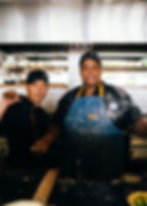Ravishing Ramen and it's History
- Kingston Li
- Sep 15, 2023
- 3 min read

Ramen's history in Japan can be traced back to China, where wheat noodles were a staple. Chinese immigrants introduced these noodles to Japan in the late 19th century. Initially, ramen was a simple dish consisting of Chinese-style wheat noodles served in a soy-based broth. It was commonly sold from street stalls.
After World War II, ramen underwent significant changes. Japanese chefs began experimenting with different broths and toppings, leading to the development of various regional ramen styles, including shoyu (soy sauce), miso (fermented soybean paste), and tonkotsu (pork bone) ramen.
In 1958, Momofuku Ando, a Taiwanese-Japanese inventor, created the world's first instant ramen noodles, known as "Chikin Ramen." This innovation revolutionized the way people consumed ramen, making it convenient and accessible worldwide.
The 1980s saw a "ramen boom" in Japan, with numerous ramen restaurants opening across the country. This period contributed to ramen becoming an integral part of Japanese food culture. Japan even has ramen museums, such as the Shin-Yokohama Ramen Museum in Yokohama, which showcases the history and various regional styles of ramen.

Ramen chefs are often referred to as "ramen masters." Achieving this title requires years of training and dedication to perfecting the art of ramen preparation.
In 2005, Japanese astronaut Soichi Noguchi became the first person to eat ramen in space. He enjoyed a vacuum-sealed version of instant ramen on the International Space Station. Jiro-style ramen is known for its massive portions and a focus on hearty ingredients like thick noodles, a mountain of bean sprouts, and a pile of pork. It's considered one of the most extreme and filling ramen varieties.
Some ramen shops in Japan have vending machines at the entrance where customers can purchase meal tickets, customize their order, and then hand the ticket to the chef. Ramen has been featured in several popular anime series, including "Naruto," where the main character, Naruto Uzumaki, loves ramen, and "My Neighbor Totoro," where a famous scene involves a bowl of ramen.

Japan hosts annual ramen competitions, such as the Tokyo Ramen of the Year Grand Prix, where top ramen chefs and shops compete for prestigious awards. Some ramen enthusiasts have specific rituals for eating ramen, such as tasting the broth first to assess its flavor profile and then enjoying the noodles and toppings.
Ramen tourism is a real phenomenon in Japan, with travelers embarking on "ramen pilgrimages" to visit renowned ramen shops and try regional specialties.
The process of making ramen noodles involves kneading and pulling the dough repeatedly to create the desired texture. This requires skill and practice to achieve consistent results. In recent years, there has been a trend toward healthier ramen options, with some restaurants offering low-sodium or vegetarian versions to cater to health-conscious consumers.

Talented chefs and food artists create intricate and realistic ramen replicas from plastic or wax, which are often displayed in restaurant windows to showcase the menu items. Ramen has influenced and been influenced by other cultures. For example, in the United States, ramen has been adapted and fused with local ingredients to create unique variations.
Some Japanese towns and regions host annual ramen festivals, celebrating the local ramen culture and inviting visitors to sample a wide range of ramen styles in one place. In traditional ramen shops, it's customary to finish your bowl of ramen entirely, including the broth. Leaving broth behind may be seen as disrespectful to the chef's craftsmanship.
In Japanese culture, it's considered polite to slurp your noodles when eating ramen. Slurping is a way to show appreciation for the dish and to cool down the hot noodles. Ramen varies greatly from region to region in Japan. For example, Sapporo in Hokkaido is known for its rich miso ramen, while Hakata in Kyushu is famous for its creamy tonkotsu ramen.

Restaurants often have creative and sometimes quirky names. These names can be inspired by the owner's name, location, or a unique aspect of the shop. Ramen toppings are diverse and include ingredients like chashu (braised pork), menma (fermented bamboo shoots), soft-boiled eggs, nori (seaweed), and green onions. These toppings can be customized to suit individual preferences.
Japan hosts numerous ramen festivals throughout the year, where visitors can sample a wide variety of ramen styles from different regions and vendors. Ramen has made its mark in Japanese pop culture through movies, anime, and manga. The dish often serves as a symbol of comfort and nostalgia in storytelling.

Some ramen restaurants offer eating challenges where customers must finish an exceptionally large bowl of ramen within a specified time to win prizes or recognition. Despite its reputation as a comfort food, ramen can be nutritious. Ingredients like seaweed, vegetables, and lean protein can provide a balanced meal.
Ramen enthusiasts in Japan often form clubs or groups dedicated to exploring and reviewing different ramen shops, sharing their experiences and recommendations.
Ramen's journey through Japanese culture is a fascinating blend of history, innovation, and regional diversity, making it a beloved and iconic dish that continues to evolve and capture the hearts of people worldwide.

